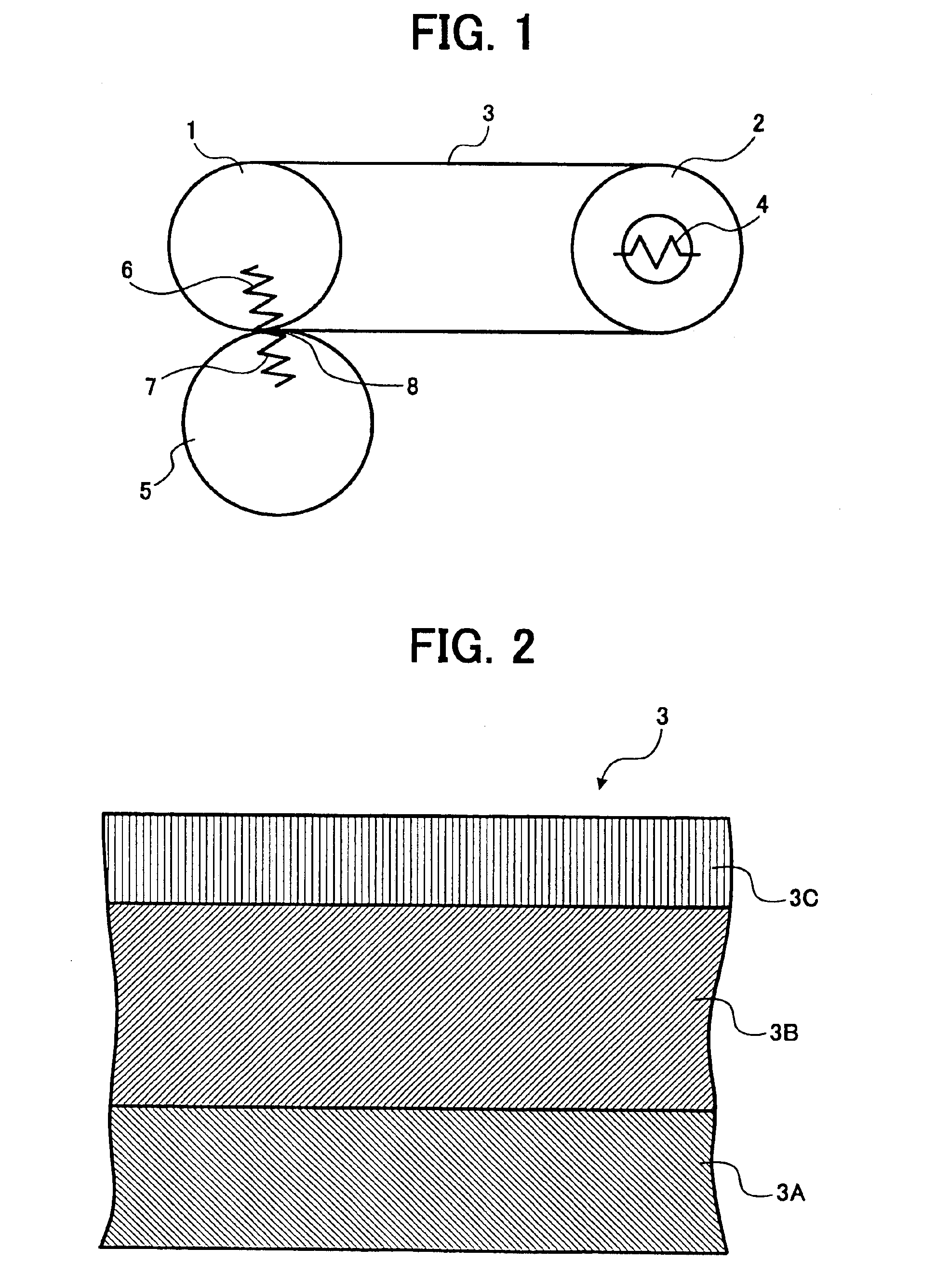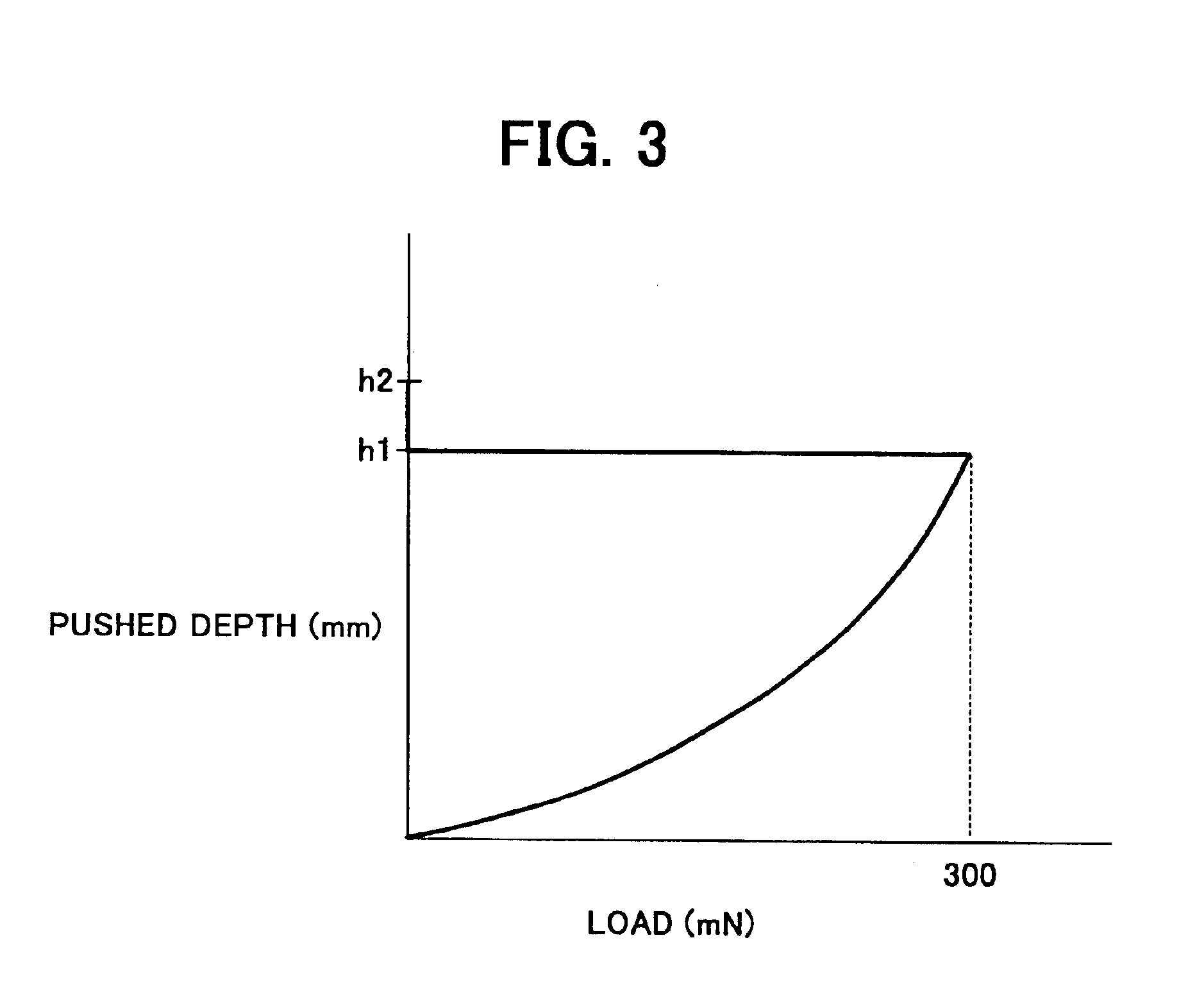Fixing belt and method for evaluating it
a technology of fixing belt and nipping portion, which is applied in the direction of electrographic process, cellulosic plastic layered products, instruments, etc., can solve the problems of high possibility, partial convexes and concaves, uneven pressure distribution in the nipping portion, etc., and achieve the effect of preventing the occurrence of crumples on the material paper during the fixing process
- Summary
- Abstract
- Description
- Claims
- Application Information
AI Technical Summary
Benefits of technology
Problems solved by technology
Method used
Image
Examples
embodiment 1
[Embodiment 1]
At first a plurality kind of triple layer fixing belt 3 which is composed of the substrate 3A, the elastic layer 3B and the mold releasing layer 3C, are prepared and creep values of the respective fixing belt 3 are measured and then an experiment whether or not an occurrence of crumple does occur on a paper is performed with loading the respective fixing belt 3 on a belt fixing device as well.
For example as one example of the fixing belt 3 a substrate 3A which is made of poly-imide resin and it has dimensions of 60 mm diameter, 315 mm length and 50 μm thickness, is prepared, and a silicon rubber (hardness 25 degree by JIS: Japanese Industrial Standard K 6301) layer having 200 μm thickness is formed as the elastic layer 3B on the substrate 3A, and FEP resin layer having 8 μm thickness is further formed as the mold releasing layer 3C on the elastic layer 3B and a test piece of the fixing belt is made. The creep value at the surface of this fixing belt 3 is examined and t...
embodiment 2
[Embodiment 2]
Secondly a creep value of the elastic layer 3B is measured to thereby observe a relation between the value and the occurrence of crumple about the elastic layer 3B which is formed on the substrate 3A as well. At this point the substrate a 3A and the elastic layers 3B are quite the same as prepared for the Embodiment 1 as described above.
As a result when they are compiled, it is found out that there is a tendency as shown in FIG. 5 between the creep values and the occurrences of crumples.
Judging from FIG. 5 it is found out that there is no occurrence of crumple on the material paper when the creep value CHU of the elastic layer 3B is included within a range B which is defined by a formula 0.05≦CHU≦0.80(%).
embodiment 3
[Embodiment 3]
Thirdly a creep value of the mold releasing layer 3C is measured to thereby observe a relation between the creep value and the occurrence of crumple on the material paper about the mold releasing layer 3C which is formed on the substrate 3A as well. At this point the substrates 3A and the mold releasing layers 3C are quite the same as prepared for the Embodiment 1 as described above.
As a result when they are compiled it is found out that there is a tendency as shown in FIG. 6 between the creep values and the occurrence of crumple.
Judging from FIG. 6 it is found out that there is no occurrence of crumple on the material paper when the creep value CHU of the mold releasing layer 3C is made within a range C which is defined by a formula 3.0≦CHU≦6.0(%).
PUM
| Property | Measurement | Unit |
|---|---|---|
| Fraction | aaaaa | aaaaa |
| Fraction | aaaaa | aaaaa |
| Fraction | aaaaa | aaaaa |
Abstract
Description
Claims
Application Information
 Login to View More
Login to View More - R&D
- Intellectual Property
- Life Sciences
- Materials
- Tech Scout
- Unparalleled Data Quality
- Higher Quality Content
- 60% Fewer Hallucinations
Browse by: Latest US Patents, China's latest patents, Technical Efficacy Thesaurus, Application Domain, Technology Topic, Popular Technical Reports.
© 2025 PatSnap. All rights reserved.Legal|Privacy policy|Modern Slavery Act Transparency Statement|Sitemap|About US| Contact US: help@patsnap.com



